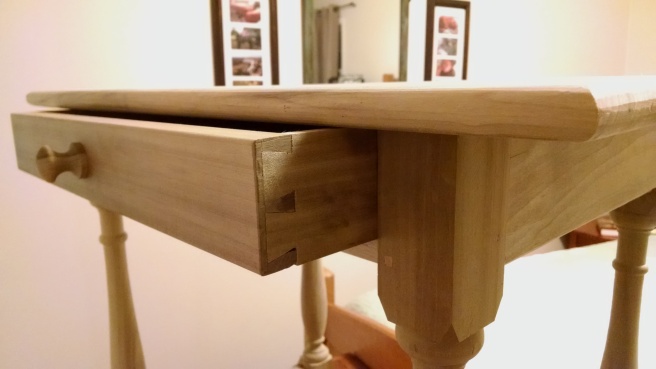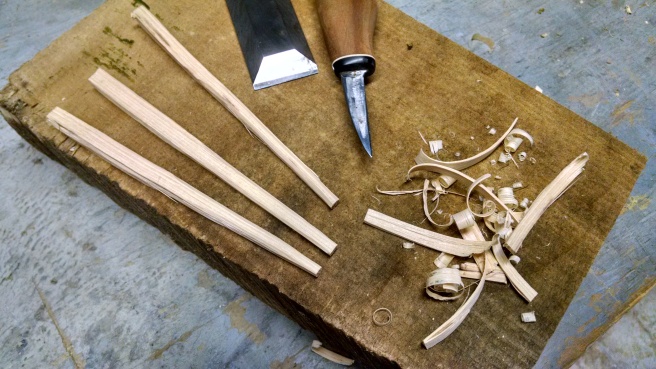Wow, I see that almost a month has passed since my last post on the tavern table. Hard to believe it’s been that long, but I’ve finally completed the finish after pecking away at it on evenings and weekends. I honestly think it may be the last time I use milk paint for a long while. I love the results, but it is ridiculously labor-intensive. Look for some experimentation with alternatives – oil paints and tinted shellac – in future blog posts.
When I left off, I had just burnished the second coat of ‘Goldenrod’ and applied a layer of orange shellac.

It’s a bit gaudy to modern eyes at this point, though I believe a color similar to this was pretty popular for Windsor chairs in the late 1700s (those folks liked brighter colors than we tolerate today).
The next step was to cover the Goldenrod with a couple coats of ‘Peacock’.

Originally, my plan was to paint the top the same color as the base, but once I got the Peacock on the base, I realized that the table actually looked really good with a contrasting top. I decided that a layer of red paint, judiciously rubbed through to the yellow below, might look even better.
Rather than marching forward with more milk paint, I decided to experiment with some oil paint instead:




The final step was to rub down the whole table with Scotch-Brite pads. I tried to simulate age by rubbing through the top coat in predictable locations: around the drawer knob, on the corners and edge of the top and legs, and especially on the tops of the stretchers where feet should rest. I stopped short of “distressing” the piece with dents, scratches, rasping, and sanding. I don’t have the willpower to spend the time on a good and realistic distressed finish, and a poorly distressed piece (AKA “shabby chic”) is, shall we say, not to my taste.

Finally, after an hour of burnishing, the table was ready for its final coat: a layer of home-brewed wiping varnish (1/3 boiled linseed oil, 1/3 satin oil varnish, 1/3 turpentine).
The final coat highlighted my second major annoyance with milk paint (the first being labor): It changes color dramatically when the oil is applied. I quite liked the blue-green appearance of the unfinished milk paint. But the second you apply the varnish (or oil, or shellac, or any other protective finish), the color darkens more than you might expect.


Now, don’t get me wrong: I’m quite happy with the final appearance of the table. I’m just annoyed that I couldn’t predict how it would look until after the varnish was applied. If I had a specific color that I was trying to match, I would have been far more annoyed. The nice thing about oil paints and tinted shellac is that the color looks pretty much the same when it’s mixed, when it’s going on, and when it dries. Milk paint, on the other hand, has one shade when you mix it, a different shade completely when it dries, and yet another completely different shade when you finish it. Unless you are deeply familiar with the product, it’s just unpredictable.
Anyway, enough of my ranting. How about some glamour shots of the finished table?





















 Fast-forward to 2011. I was building a queen-size Arts-and-Crafts bed for my wife. The rails were 5′ long – a foot longer than my clamps. It was the perfect opportunity to try a bit of drawboring, since the pegs will pull the joints tight, rather than relying on clamps. I resorted to the method that I had used many times before for pegged joints. I grabbed some offcuts of white oak, split them to get straight-grained pieces, and turned them to size on my lathe. I even gave the ends a really good taper to help the pegs find their way through the offset.
Fast-forward to 2011. I was building a queen-size Arts-and-Crafts bed for my wife. The rails were 5′ long – a foot longer than my clamps. It was the perfect opportunity to try a bit of drawboring, since the pegs will pull the joints tight, rather than relying on clamps. I resorted to the method that I had used many times before for pegged joints. I grabbed some offcuts of white oak, split them to get straight-grained pieces, and turned them to size on my lathe. I even gave the ends a really good taper to help the pegs find their way through the offset.









